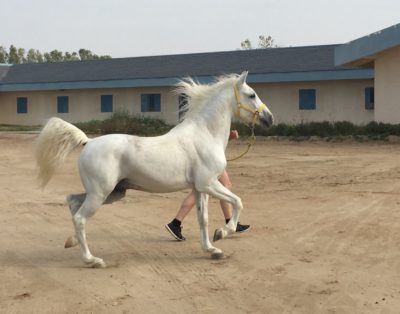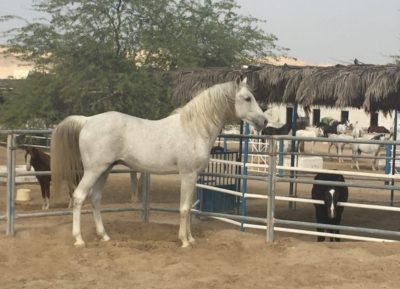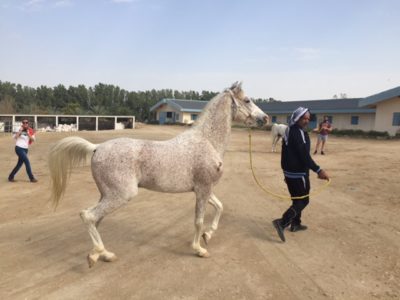Bahraini stallions in the flesh
I finally saw the Arabian horses of Bahrain, those “Pearls of Great Price”, after a 30 year wait. Thanks to Jenny Lees who arranged the private visit to the Stud of the late Sheikh Mohammad Bin Salman Aal Khalifah, we, my father and I, had the privilege of seeing these horses two days before their presentation. In an unforgivable episode of forgetfulness, I only brought my camera phone, the battery of which died after snapping photos of the third stallion. The others are in my head, just like hundred of other horses seen but not photographed.
Most impressive among the horses of the late Sh. Mohammed was a grey Hamdani (no photos). An older Rabdan, a chestnut Sa’eedan, a grey Tuwaisan, a grey Shawafan, and a dark chestnut Radban, many of these sons of the older Radban. The three below were among my favorites: from top to bottom: a very showy ‘yellow Ubayyan; a very balanced and powerful Jellabi; and a more refined, drier speckled Mlolshaan.



I’ve said it before and I’ll say it again WOW! If only some of the cradle country traditional breeders would ship semen to us here in the west the genetic wreckage that has ruined SOME(not all)of our general list lines could be corrected.
Dream on..
best wishes
Bruce Peek
Glorious!
The Jellabi stallion has a good upright stance indicating the farrier is maintaining plenty of heel, along with desirable short front cannons and an overall level body balance. I’ll bet he could fly. If only.
best wishes
Bruce Peek
Power!
So much to like in these horses, as Bruce says. I never quite like the set of head and neck in the Bahraini horses that I have seen but, as I said, so much else to love, including, in those that I have met, temperament 🙂
Such a treat to see these amazing stallion
If the photos are any inkling, it must have been an incredible experience.
How fortunate that these wonderful horses exsist- my hat is off in respect to those who breed this fountain head of Arabians.
I’m with the comments above: glorious, and such a treat. You are doing an excellent job with your phone camera. You just need to keep a charger on you! Wish there was thought transference!
Lisa: A lot of the hammer headed tilt on the desert breads can be attributed to poor hands on the part of the handler. Still a lot of the desert horses did have the over developed underside of the neck thing going on. The only disciplines that a low set neck is an advantage for are cow cutting and sprint racing and sometimes trappy technically challenging low to mid height jump courses. The bascule required to safely do EVERYTHING else goes better the higher the horses neck is set. There are some lines of arabs that are able to lift their back and the base of the neck correctly to properly bascule. Among the most common are some of the Bask park horses and a lot of the Morafic line bred horses as well as the Sameh lines, now quite rare.
Awhile back Edouard had referenced a straight Egyptian breeder in I think Arkansas who preserved some of the G.A.F. horses. Their horses were able to lift their back into true collection instead of inverting and dropping their spine. In all my years of attending Arabian shows and looking at general list purebreds I have seen two mares at farms and a handful of ridden arabs at dressage shows who could do this. So correct stance and movement is out there. It is up to the very few intelligent horsemen now active to develop the ability to bascule in the stock they beeed either al khamsa or general list. We need to start an organization of riders, trainers and breeders to teach the inversion trainers, riders and breeders how wrong they are and how to fix it. Without true usefulness under saddle Arabians will continue down their road to nowhere as pasture ornaments. Pasture ornamentation is the real reason why thousands of them are consigned to slaughter when the market periodically collapses in economic downturns. ( yes I know yet another Arabian interest group not my idea of a good time either)
best wishes
Bruce Peek
Dear Bruce,
As ever I agree 🙂
You know how I feel about Arabians being ridden, their beauty is a function of their utility and I believe every Arabian horse, accidental injury aside, should be proven under saddle before being bred from. I’ve said it before, having an inhand (halter) Arabian to me is the equivalent of owning a Ferrari, keeping it in a garage and only ever taking it out to be towed around rather than driven.
Anyway as to the specifics, I agree with you that to an extent appalling hands/handling can certainly negatively affect the neck position and development, but I have seen and ridden (‘general list’ ) Arabian horses who do naturally (at liberty, in hand or under saddle , engage properly and flex beautifully through the back and neck. However I would agree that a really supple bascule through the whole back is not found universally or even commonly.
That notwithstanding, surely an elegant neck and open arch of throat are hallmarks of an Arabian even if they do not always truly lift and round the back as would be the ideal in dressage or jumping etc I hope that I have understood the term ‘mitbah’ correctly?
One point is that cow cutting and sprint racing are fair approximations of the type of functionality required in a Ghazu!(devils advocate!)
I suppose I am saying that I agree that engagement and rounding through the whole back is the ideal we should train for and is not always/often found in Arabs. However they have a great agility and degree of hock engagement even if a little blocked through the back itself, (as opposed to the limbs and sacroiliac), that renders them supremely manoeuvrable, maybe in the more horizontal cowcutting/Ghazu style rather than the elevated dressage style, but….. even then ….I would expect to see a nice set of head and neck, refined arch of throat and not a heavy underneck ?
I hope I have not made too much of a mess of trying to explain my thoughts here, as there are, to my mind, two different things that we are discussing here?
IE Firstly full proper engagement through the whole topline (ideal and to be trained for (horse) and as you rightly say educated for (human)) and secondly an (at least)lovely natural open arch of throat that when missing and worse when linked to an over developed underneck gives an ‘unArabian’ coarse look to a horse IMO (!)
I am talking generally here and not with reference to the photos as in at least two the horses are tense/excited with head raised and eyes focussed forward, this can give a false impression of neck set. What is more, again, there is a huge amount to like in these horses so very far be it from me to be critical.
Cheers
Lisa
Thank you, Edouard, and no, you will not be forgiven for forgetting to charge your battery. I’m a lot older than you, and I’ve wanted to see these horses forever. But, three pictures are better than nothing and some took videos, and they will be rewarded in the afterlife. You, will get a lecture on lack of foreseeability,
Thanks,
Lorriee
The speckled grey in the 3rd foto is Mlolshaan Enaad (2009, Krayaan Sager/Mlolesh Al Haiza. Krayaan Sager (1997) was by Dhahmaan Shaban out of Kray Hanan. Mlolesh Al Haiza (1999) was by Kuheilaan Umm Zorayr Al-Dheleem out of Mlolesh Noor.
The top photo is of Obeyaan Azheer (2003, Dhahmaan Shaban/Obeyah Al Gabra. Dhahmaan Shaban (1988) is by Molshaan Almarshoosh (1958) out of the Saudi bred mare Dhahmaa Umm Amer (1970), who came to Bahrain in 1984. Obeyah Al Gabra (1994) is by Jellaby Kher out of Obeyah Saada.